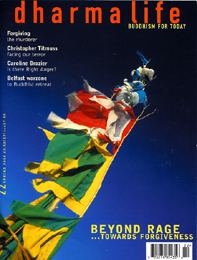A phoenix raised from the ashes
Robert Hirschfield meets Leakena Tep, the fundraising inspiration behind the creation of a new Buddhist centre on a former killing field in Cambodia
Leakena Tep is a Buddhist, a builder and a Killing Fields survivor. Her apartment building, on Father Zeiser Place in the West Bronx, was dingy, the walls overrun with graffiti. In her apartment was a map of Cambodia, a statue of the Buddha.
I was invited over by Rathanak Choun, Leakena Tep's 18 year-old son and my translator, who slouched beside us like a Cambodian James Dean. In my interview with him, the boy had alluded to a meditation centre on top of a hill in western Cambodia for which his mother had raised an astonishing $100,000. It was built on a Khmer Rouge execution site.
Tep, tiny, aloof, compact, handed me a glass of water, and slipped a video into the VCR. She knew from her son that I was a writer, and wasted no time with small talk. She has lost enough time already: four years of hard labour (from 1975 to 1979) in the death camps of Pol Pot.
She came from a family of restaurant owners, although according to Rathanak, 'her cooking is so bad, I can't believe she ever had anything to do with a restaurant'. Nevertheless Tep had to endure the special severity reserved by the Khmer Rouge for property owners, professionals, intellectuals, even wearers of glasses, whom the communists deduced were intellectuals, and therefore class enemies. Once, half-starved, Tep had a heavy sack of rice thrown at her with the intention of killing her. It maimed her hand. 'One of my sons was killed. Two of my sisters starved to death. Three of my uncles were executed.'
On the video the first image I saw was a pile of stones. They didn't look like much, baking in the sun at the foot of Tep's hill. But they were the Buddhist centre's first building stones. The year was 1993. 'The Khmer Rouge destroyed everything,' Tep related. 'Some Cambodians have been working on projects to rebuild Cambodia materially. I was keen to do something to help rebuild Cambodia spiritually.'
Beneath an immense blue sky, labourers were sculpting a winding road. On top of the hill a low, wood-and-cement structure was going up in the middle of nowhere. (Actually, it was near the Thai border, where Cambodians trying to escape were caught and shot.)
Tep, endowed with organisational abilities that Rathanak finds alternately uplifting and effacing, visited Cambodian émigrés along the US eastern seaboard and contacted others further away, to raise the funds for her project. A factory worker in Pittsburgh gave $7,000 - his entire life savings. Money also trickled in from Cambodians subsisting on Welfare checks and SSI (Supplemental Security Income) disability cheques. Bit by bit she somehow gathered the necessary $100,000.
Being herself on SSI due to a serious heart ailment, Tep is unable to return to Cambodia and meditate in her new Buddhist centre. The centre once displayed her picture, but she asked them to take it down: 'It's wrong,' she said, 'to glorify someone that way. It only creates problems.' Perhaps she was thinking of Pol Pot, under whose rule nearly two million people were killed.
Like Sol Mang, the monk at the Cambodian Buddhist temple in the Bronx, Tep is emphatic about how former members of the Khmer Rouge should be treated. 'They should be given a second chance. According to Buddhist teachings, if you take revenge on those who mistreat you, you tie yourself to their karma.' In other words, their negative karma is their punishment. No need to tamper with the cosmic order of things.
Tep's life in the Bronx is almost reclusive. Apart from her walks to the temple, and visits to the doctor, she mainly stays at home; she meditates and cooks for her three sons, of whom Rathanak is the youngest. Her husband abandoned the family shortly after their arrival in 1983.
I asked her how she has adjusted to life in America. 'Impermanence is one the main teachings of the Buddha,' she said. 'I am here because of impermanence. It can be hard sometimes. I don't speak the language. The pace of life is so fast. It's a challenge.'
In the Jotanaram Temple in the Bronx - in that space transplanted from Cambodia - I see Tep bowing to the Buddha images, chatting with her women friends, serving food to the monk. She is respected, happy, at home. Unlike most of her community, who have chosen to remain permanent residents, Tep has turned herself into a us citizen. A gesture made in a blaze of gratitude.
On the video Tep watched the Buddhist centre, her creation, unfold with maternal pride. As builders in Cambodia were discussing the logistical difficulties of pumping water up to the centre, Tep flashed a mischievous smile. She had provided information on this all the way from the Bronx.
The centre in Cambodia officially opened in July 2000. On top of the hill, festively, was a reception committee of monks and nuns, as well as some women chosen for the occasion because they were beautiful and young. The monastics greeted a procession of little children from the village with smiles and blessings. The children were given gifts: writing pads and pens - luxuries in that remote outpost.
One monk was holding an urn. I asked Tep about it. 'An English monk gave me the bone of an Arhat he knew. He asked me to inter it beneath the Buddhist centre for him.' The new centre now stands as a potent symbol of the Buddha's teaching - purifying the ground that was once a Khmer Rouge execution site.
Robert Hirschfield writes about Buddhism and lives in New York City



